Country Risk in Pharmaceutical Industry: China vs South Africa
VerifiedAdded on 2022/12/29
|18
|3757
|63
AI Summary
This document analyzes the country risk in the pharmaceutical industry of China and South Africa, evaluating the opportunities and entry methods for AUSMED. It discusses the political, economic, and cultural risks in both countries, as well as the financial and commercial risks. The document also explores the potential opportunities for AUSMED in the South African market and suggests the licensing method as the best entry strategy.
Contribute Materials
Your contribution can guide someone’s learning journey. Share your
documents today.
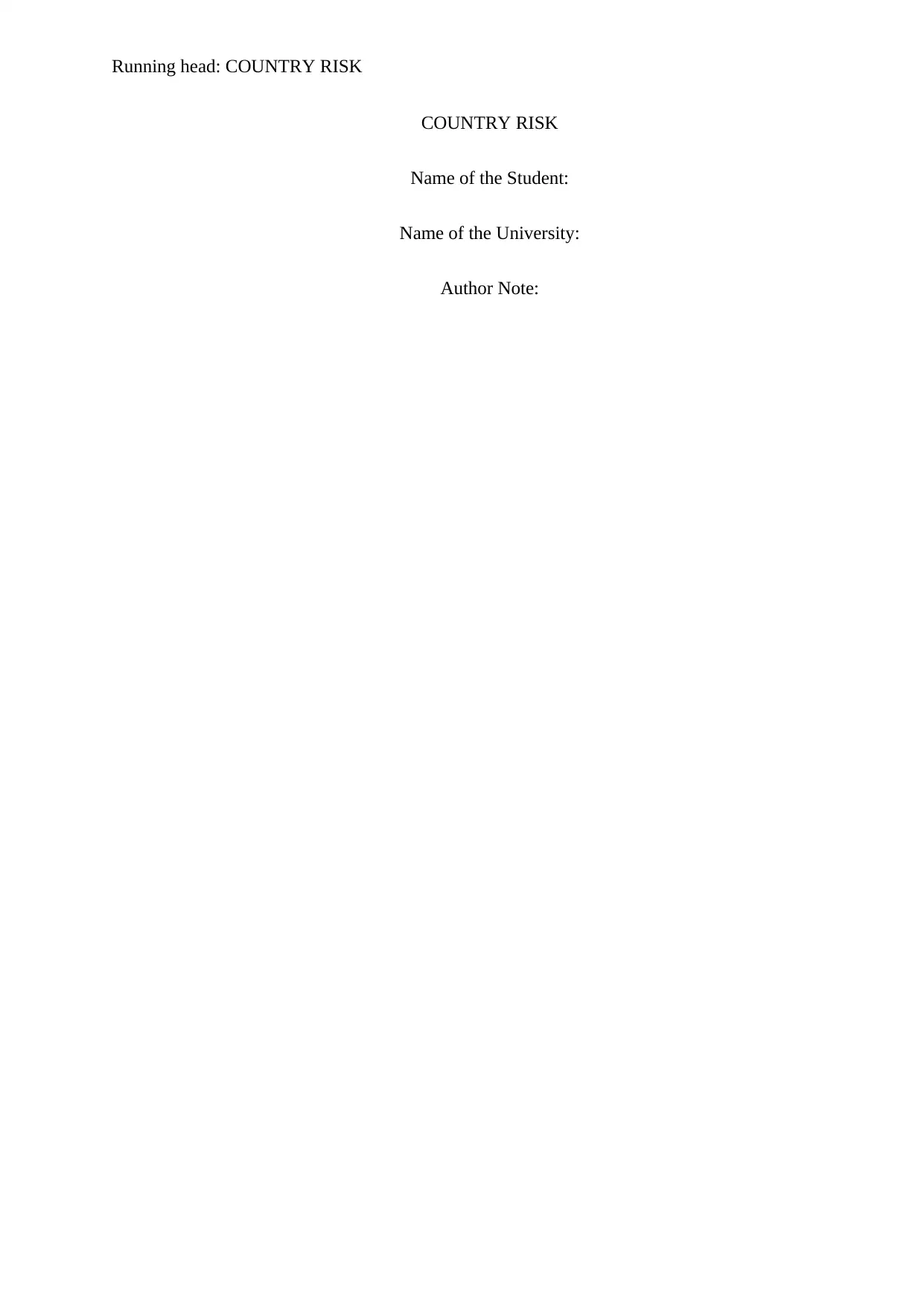
Running head: COUNTRY RISK
COUNTRY RISK
Name of the Student:
Name of the University:
Author Note:
COUNTRY RISK
Name of the Student:
Name of the University:
Author Note:
Secure Best Marks with AI Grader
Need help grading? Try our AI Grader for instant feedback on your assignments.
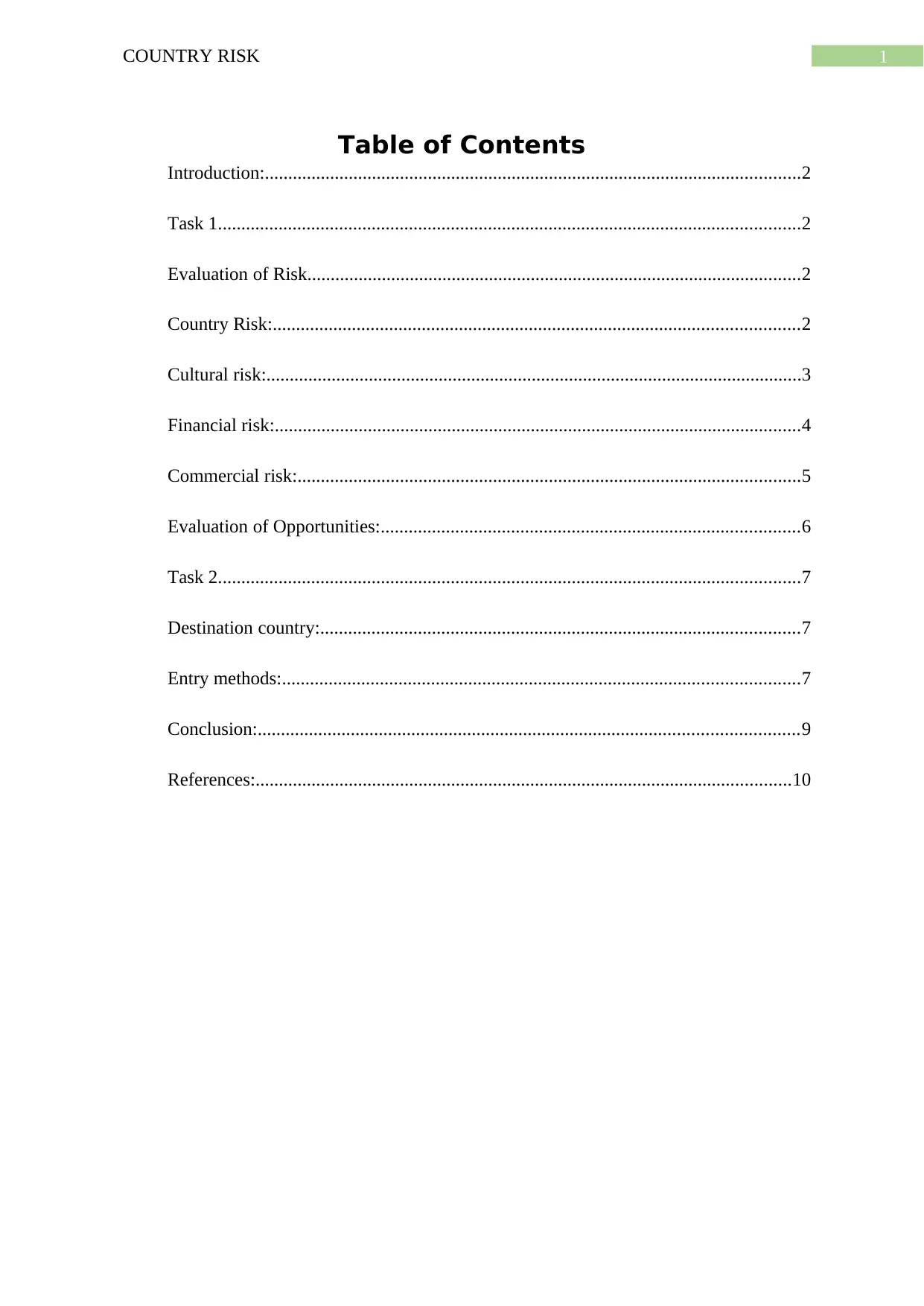
1COUNTRY RISK
Table of Contents
Introduction:...................................................................................................................2
Task 1.............................................................................................................................2
Evaluation of Risk..........................................................................................................2
Country Risk:.................................................................................................................2
Cultural risk:...................................................................................................................3
Financial risk:.................................................................................................................4
Commercial risk:............................................................................................................5
Evaluation of Opportunities:..........................................................................................6
Task 2.............................................................................................................................7
Destination country:.......................................................................................................7
Entry methods:...............................................................................................................7
Conclusion:....................................................................................................................9
References:...................................................................................................................10
Table of Contents
Introduction:...................................................................................................................2
Task 1.............................................................................................................................2
Evaluation of Risk..........................................................................................................2
Country Risk:.................................................................................................................2
Cultural risk:...................................................................................................................3
Financial risk:.................................................................................................................4
Commercial risk:............................................................................................................5
Evaluation of Opportunities:..........................................................................................6
Task 2.............................................................................................................................7
Destination country:.......................................................................................................7
Entry methods:...............................................................................................................7
Conclusion:....................................................................................................................9
References:...................................................................................................................10
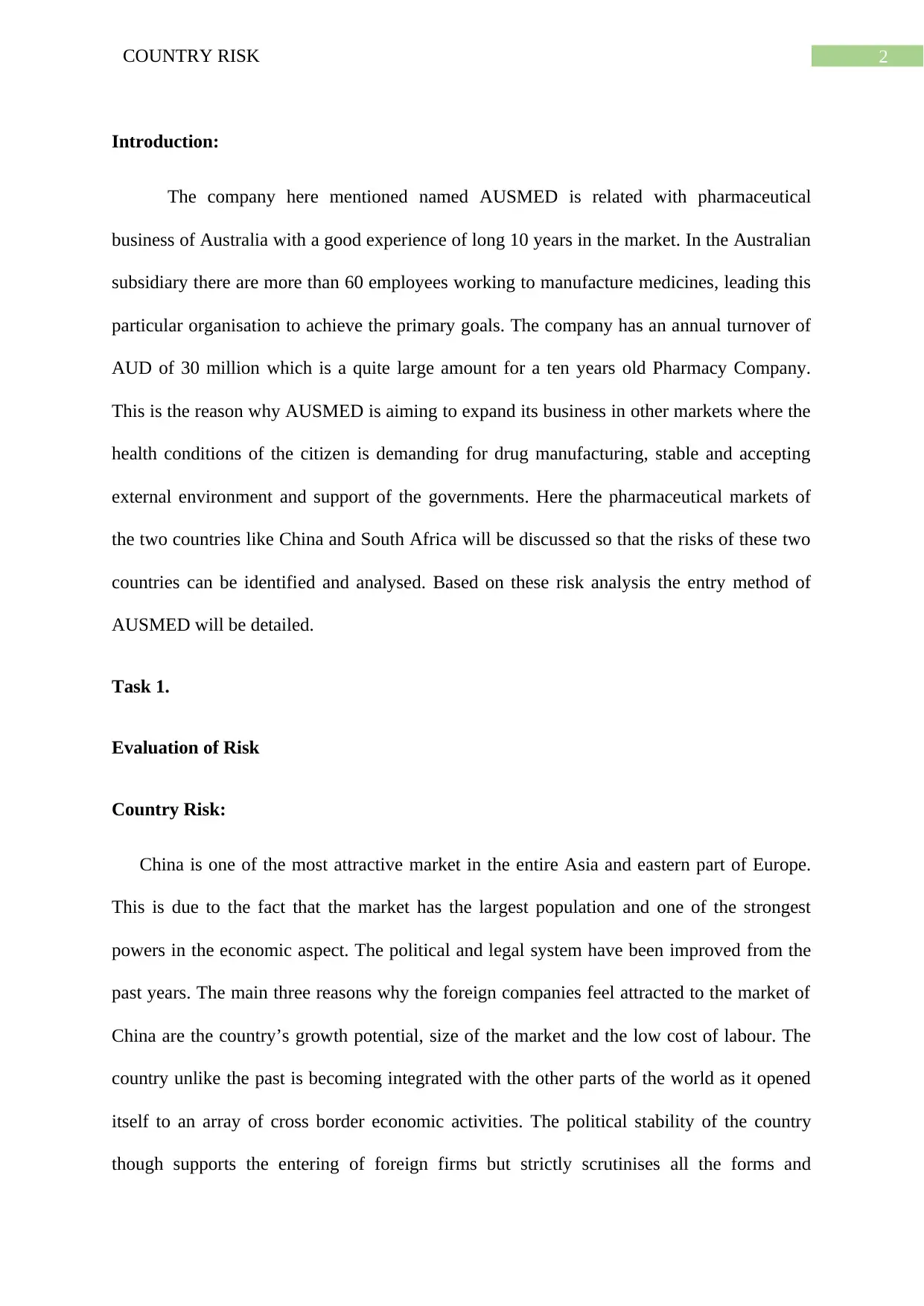
2COUNTRY RISK
Introduction:
The company here mentioned named AUSMED is related with pharmaceutical
business of Australia with a good experience of long 10 years in the market. In the Australian
subsidiary there are more than 60 employees working to manufacture medicines, leading this
particular organisation to achieve the primary goals. The company has an annual turnover of
AUD of 30 million which is a quite large amount for a ten years old Pharmacy Company.
This is the reason why AUSMED is aiming to expand its business in other markets where the
health conditions of the citizen is demanding for drug manufacturing, stable and accepting
external environment and support of the governments. Here the pharmaceutical markets of
the two countries like China and South Africa will be discussed so that the risks of these two
countries can be identified and analysed. Based on these risk analysis the entry method of
AUSMED will be detailed.
Task 1.
Evaluation of Risk
Country Risk:
China is one of the most attractive market in the entire Asia and eastern part of Europe.
This is due to the fact that the market has the largest population and one of the strongest
powers in the economic aspect. The political and legal system have been improved from the
past years. The main three reasons why the foreign companies feel attracted to the market of
China are the country’s growth potential, size of the market and the low cost of labour. The
country unlike the past is becoming integrated with the other parts of the world as it opened
itself to an array of cross border economic activities. The political stability of the country
though supports the entering of foreign firms but strictly scrutinises all the forms and
Introduction:
The company here mentioned named AUSMED is related with pharmaceutical
business of Australia with a good experience of long 10 years in the market. In the Australian
subsidiary there are more than 60 employees working to manufacture medicines, leading this
particular organisation to achieve the primary goals. The company has an annual turnover of
AUD of 30 million which is a quite large amount for a ten years old Pharmacy Company.
This is the reason why AUSMED is aiming to expand its business in other markets where the
health conditions of the citizen is demanding for drug manufacturing, stable and accepting
external environment and support of the governments. Here the pharmaceutical markets of
the two countries like China and South Africa will be discussed so that the risks of these two
countries can be identified and analysed. Based on these risk analysis the entry method of
AUSMED will be detailed.
Task 1.
Evaluation of Risk
Country Risk:
China is one of the most attractive market in the entire Asia and eastern part of Europe.
This is due to the fact that the market has the largest population and one of the strongest
powers in the economic aspect. The political and legal system have been improved from the
past years. The main three reasons why the foreign companies feel attracted to the market of
China are the country’s growth potential, size of the market and the low cost of labour. The
country unlike the past is becoming integrated with the other parts of the world as it opened
itself to an array of cross border economic activities. The political stability of the country
though supports the entering of foreign firms but strictly scrutinises all the forms and
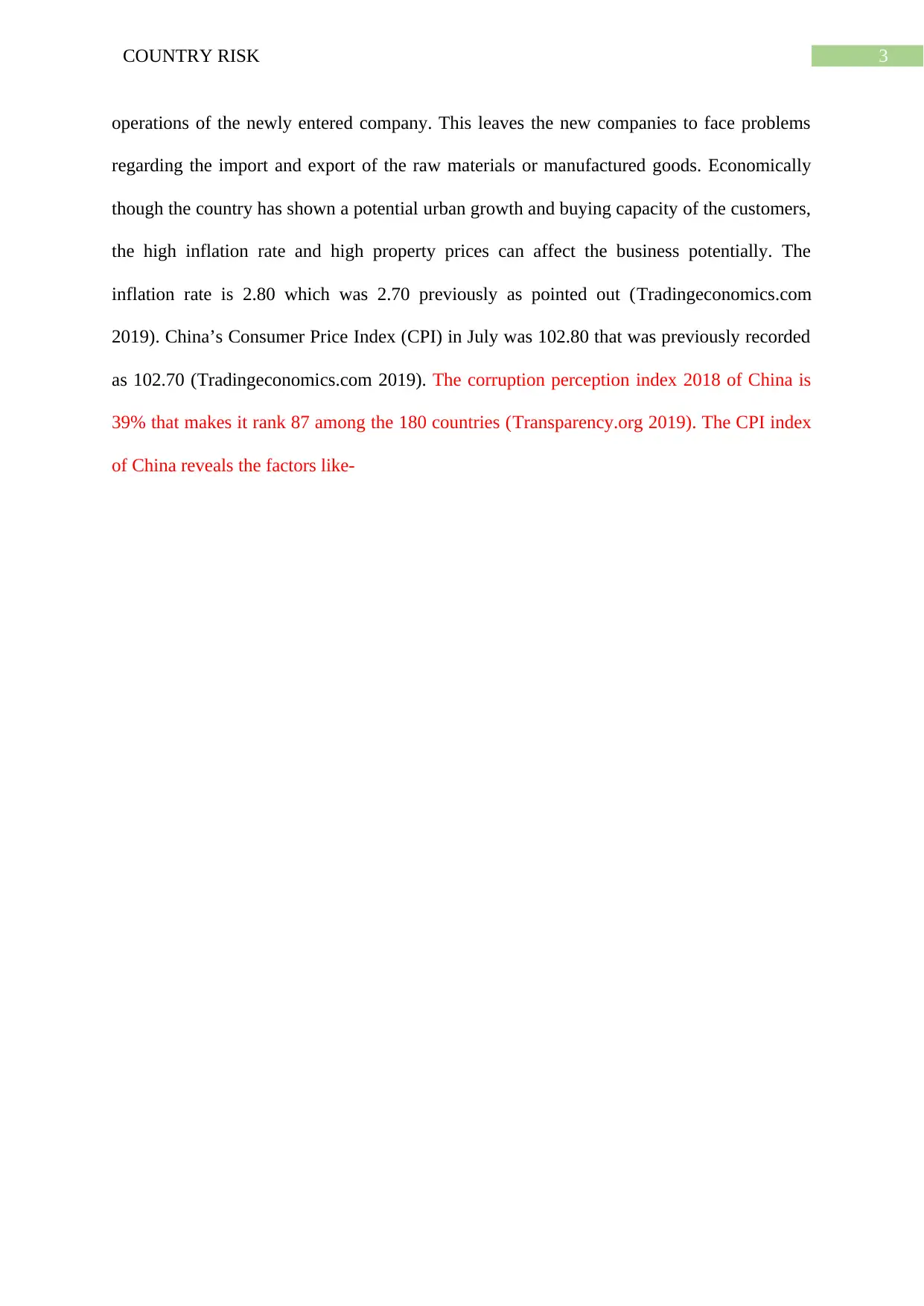
3COUNTRY RISK
operations of the newly entered company. This leaves the new companies to face problems
regarding the import and export of the raw materials or manufactured goods. Economically
though the country has shown a potential urban growth and buying capacity of the customers,
the high inflation rate and high property prices can affect the business potentially. The
inflation rate is 2.80 which was 2.70 previously as pointed out (Tradingeconomics.com
2019). China’s Consumer Price Index (CPI) in July was 102.80 that was previously recorded
as 102.70 (Tradingeconomics.com 2019). The corruption perception index 2018 of China is
39% that makes it rank 87 among the 180 countries (Transparency.org 2019). The CPI index
of China reveals the factors like-
operations of the newly entered company. This leaves the new companies to face problems
regarding the import and export of the raw materials or manufactured goods. Economically
though the country has shown a potential urban growth and buying capacity of the customers,
the high inflation rate and high property prices can affect the business potentially. The
inflation rate is 2.80 which was 2.70 previously as pointed out (Tradingeconomics.com
2019). China’s Consumer Price Index (CPI) in July was 102.80 that was previously recorded
as 102.70 (Tradingeconomics.com 2019). The corruption perception index 2018 of China is
39% that makes it rank 87 among the 180 countries (Transparency.org 2019). The CPI index
of China reveals the factors like-
Secure Best Marks with AI Grader
Need help grading? Try our AI Grader for instant feedback on your assignments.
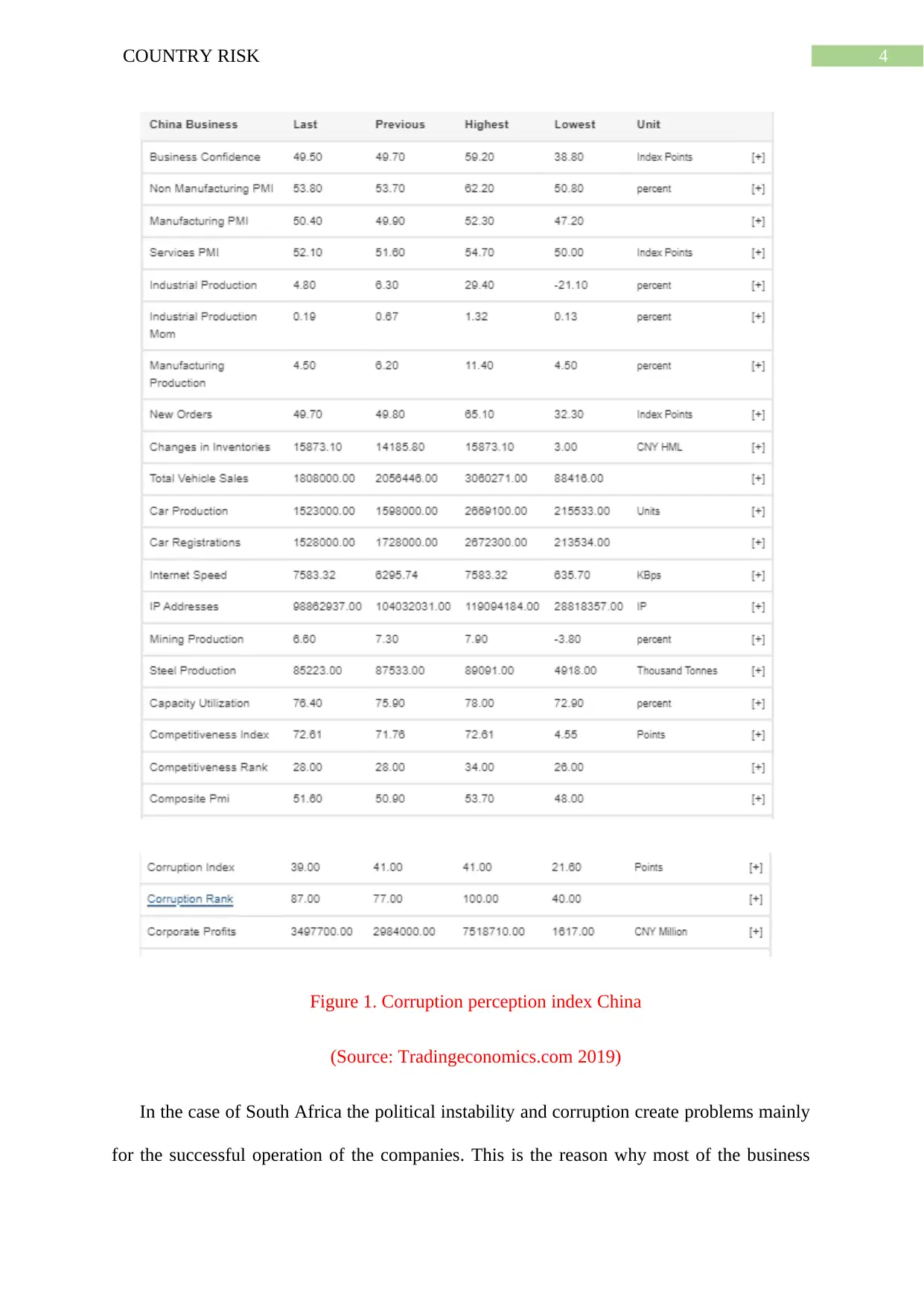
4COUNTRY RISK
Figure 1. Corruption perception index China
(Source: Tradingeconomics.com 2019)
In the case of South Africa the political instability and corruption create problems mainly
for the successful operation of the companies. This is the reason why most of the business
Figure 1. Corruption perception index China
(Source: Tradingeconomics.com 2019)
In the case of South Africa the political instability and corruption create problems mainly
for the successful operation of the companies. This is the reason why most of the business
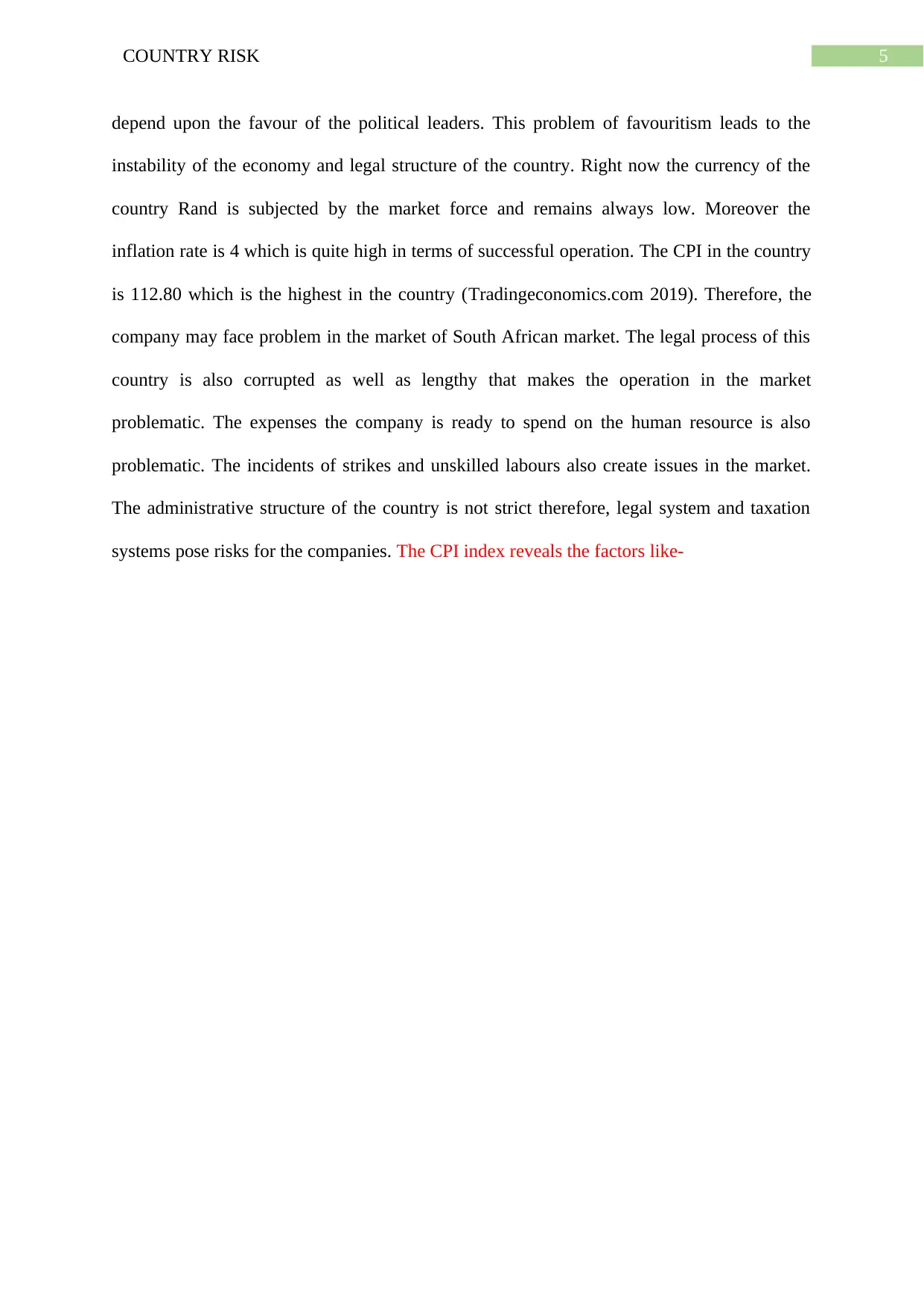
5COUNTRY RISK
depend upon the favour of the political leaders. This problem of favouritism leads to the
instability of the economy and legal structure of the country. Right now the currency of the
country Rand is subjected by the market force and remains always low. Moreover the
inflation rate is 4 which is quite high in terms of successful operation. The CPI in the country
is 112.80 which is the highest in the country (Tradingeconomics.com 2019). Therefore, the
company may face problem in the market of South African market. The legal process of this
country is also corrupted as well as lengthy that makes the operation in the market
problematic. The expenses the company is ready to spend on the human resource is also
problematic. The incidents of strikes and unskilled labours also create issues in the market.
The administrative structure of the country is not strict therefore, legal system and taxation
systems pose risks for the companies. The CPI index reveals the factors like-
depend upon the favour of the political leaders. This problem of favouritism leads to the
instability of the economy and legal structure of the country. Right now the currency of the
country Rand is subjected by the market force and remains always low. Moreover the
inflation rate is 4 which is quite high in terms of successful operation. The CPI in the country
is 112.80 which is the highest in the country (Tradingeconomics.com 2019). Therefore, the
company may face problem in the market of South African market. The legal process of this
country is also corrupted as well as lengthy that makes the operation in the market
problematic. The expenses the company is ready to spend on the human resource is also
problematic. The incidents of strikes and unskilled labours also create issues in the market.
The administrative structure of the country is not strict therefore, legal system and taxation
systems pose risks for the companies. The CPI index reveals the factors like-
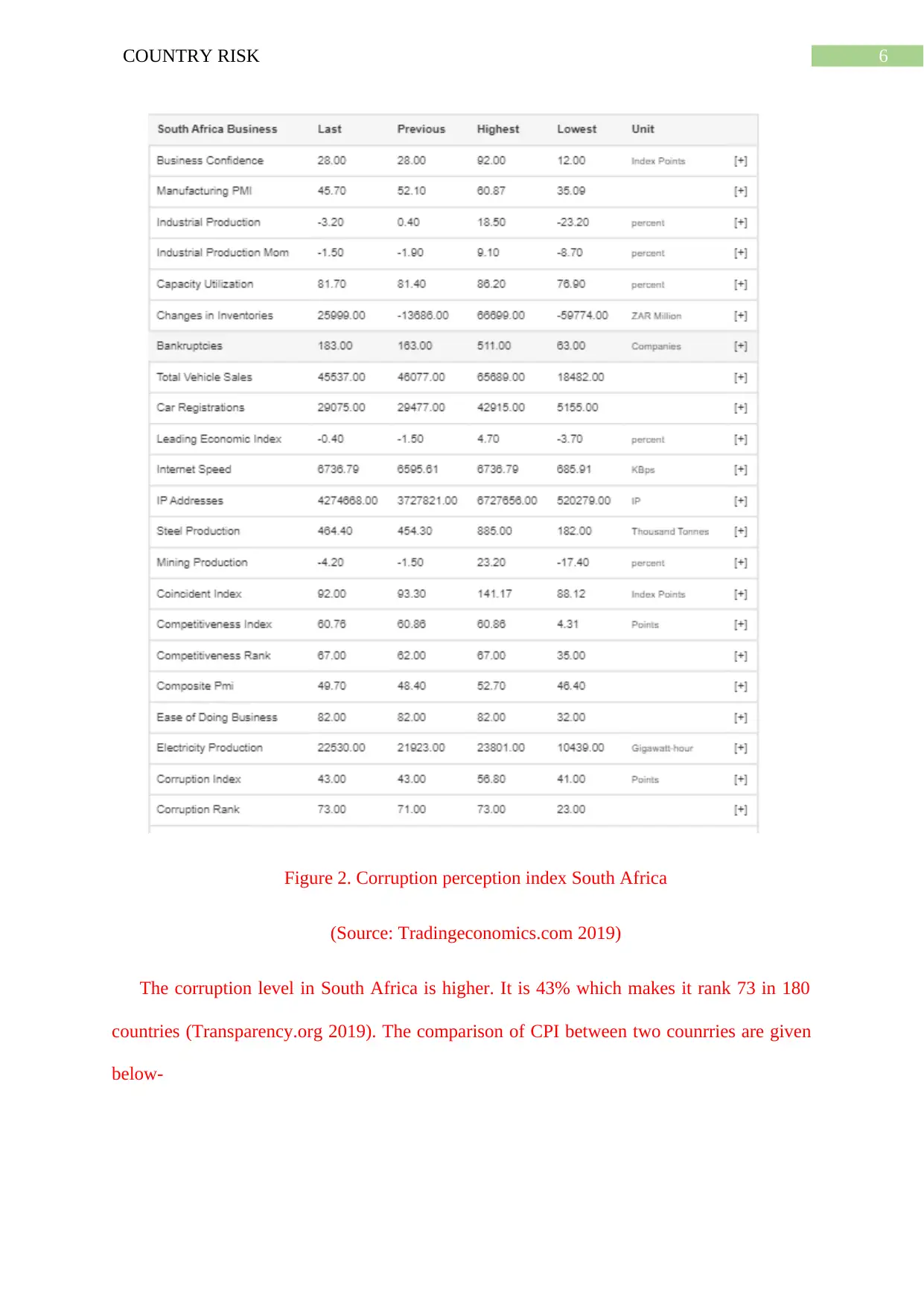
6COUNTRY RISK
Figure 2. Corruption perception index South Africa
(Source: Tradingeconomics.com 2019)
The corruption level in South Africa is higher. It is 43% which makes it rank 73 in 180
countries (Transparency.org 2019). The comparison of CPI between two counrries are given
below-
Figure 2. Corruption perception index South Africa
(Source: Tradingeconomics.com 2019)
The corruption level in South Africa is higher. It is 43% which makes it rank 73 in 180
countries (Transparency.org 2019). The comparison of CPI between two counrries are given
below-
Paraphrase This Document
Need a fresh take? Get an instant paraphrase of this document with our AI Paraphraser
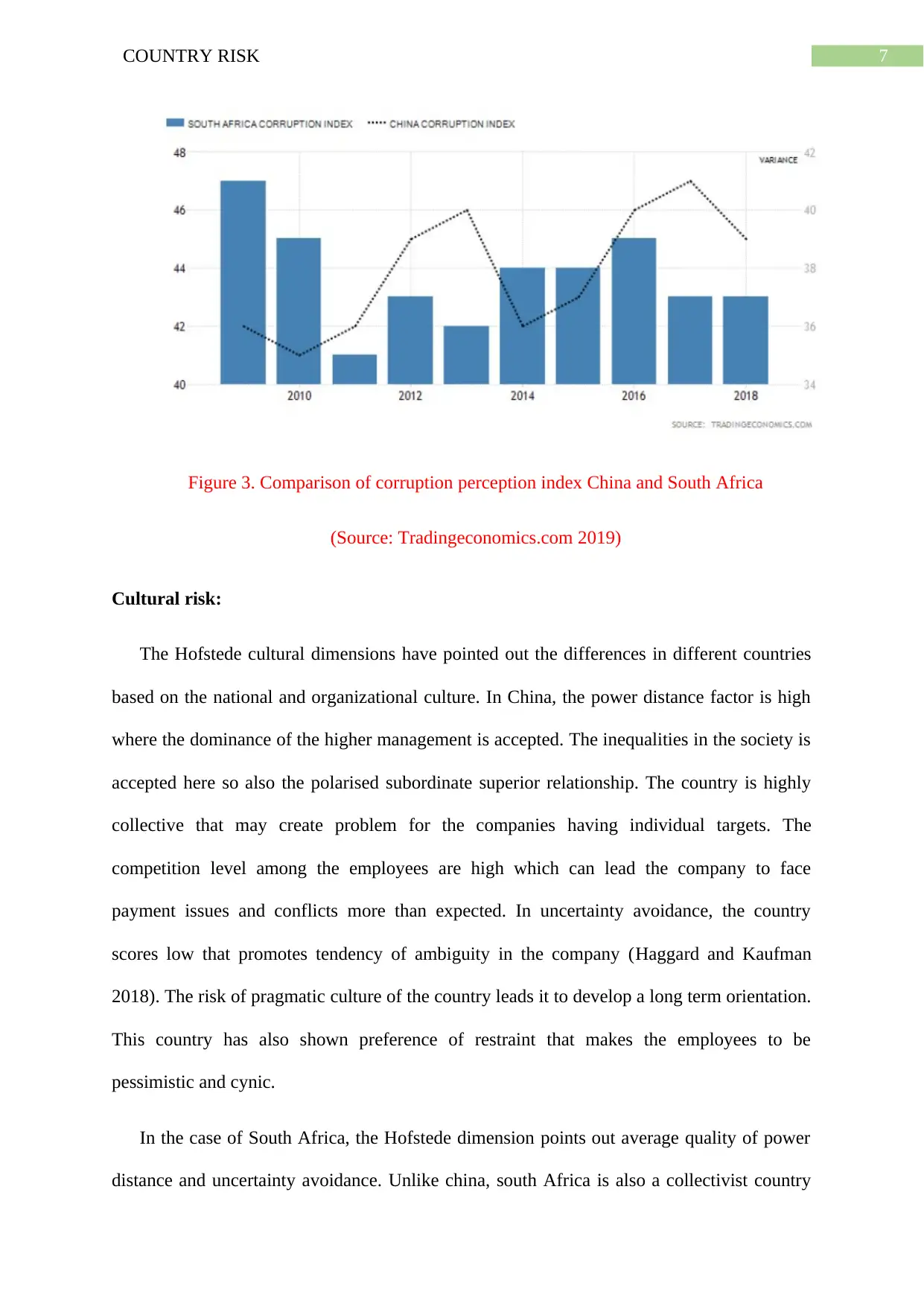
7COUNTRY RISK
Figure 3. Comparison of corruption perception index China and South Africa
(Source: Tradingeconomics.com 2019)
Cultural risk:
The Hofstede cultural dimensions have pointed out the differences in different countries
based on the national and organizational culture. In China, the power distance factor is high
where the dominance of the higher management is accepted. The inequalities in the society is
accepted here so also the polarised subordinate superior relationship. The country is highly
collective that may create problem for the companies having individual targets. The
competition level among the employees are high which can lead the company to face
payment issues and conflicts more than expected. In uncertainty avoidance, the country
scores low that promotes tendency of ambiguity in the company (Haggard and Kaufman
2018). The risk of pragmatic culture of the country leads it to develop a long term orientation.
This country has also shown preference of restraint that makes the employees to be
pessimistic and cynic.
In the case of South Africa, the Hofstede dimension points out average quality of power
distance and uncertainty avoidance. Unlike china, south Africa is also a collectivist country
Figure 3. Comparison of corruption perception index China and South Africa
(Source: Tradingeconomics.com 2019)
Cultural risk:
The Hofstede cultural dimensions have pointed out the differences in different countries
based on the national and organizational culture. In China, the power distance factor is high
where the dominance of the higher management is accepted. The inequalities in the society is
accepted here so also the polarised subordinate superior relationship. The country is highly
collective that may create problem for the companies having individual targets. The
competition level among the employees are high which can lead the company to face
payment issues and conflicts more than expected. In uncertainty avoidance, the country
scores low that promotes tendency of ambiguity in the company (Haggard and Kaufman
2018). The risk of pragmatic culture of the country leads it to develop a long term orientation.
This country has also shown preference of restraint that makes the employees to be
pessimistic and cynic.
In the case of South Africa, the Hofstede dimension points out average quality of power
distance and uncertainty avoidance. Unlike china, south Africa is also a collectivist country
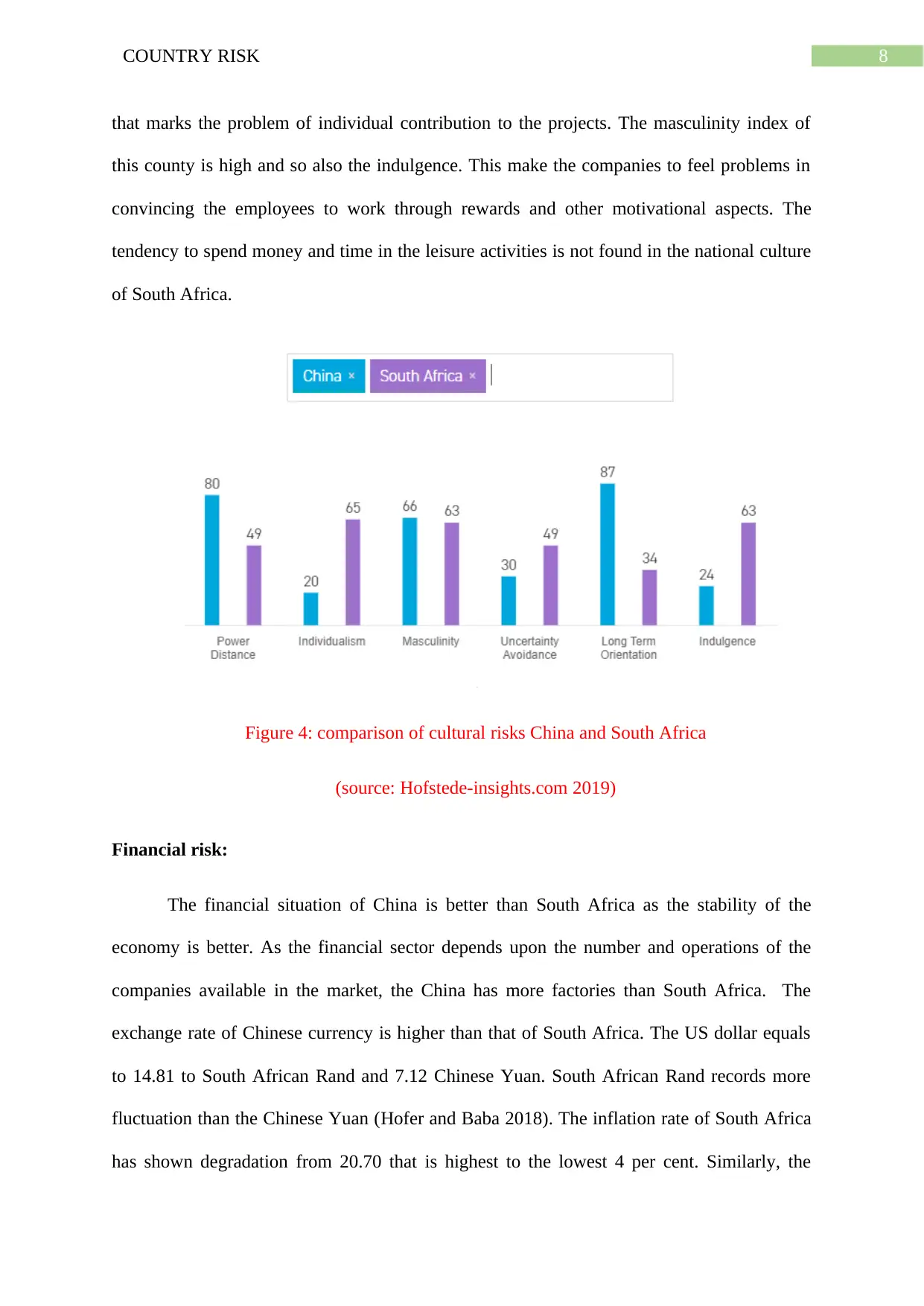
8COUNTRY RISK
that marks the problem of individual contribution to the projects. The masculinity index of
this county is high and so also the indulgence. This make the companies to feel problems in
convincing the employees to work through rewards and other motivational aspects. The
tendency to spend money and time in the leisure activities is not found in the national culture
of South Africa.
Figure 4: comparison of cultural risks China and South Africa
(source: Hofstede-insights.com 2019)
Financial risk:
The financial situation of China is better than South Africa as the stability of the
economy is better. As the financial sector depends upon the number and operations of the
companies available in the market, the China has more factories than South Africa. The
exchange rate of Chinese currency is higher than that of South Africa. The US dollar equals
to 14.81 to South African Rand and 7.12 Chinese Yuan. South African Rand records more
fluctuation than the Chinese Yuan (Hofer and Baba 2018). The inflation rate of South Africa
has shown degradation from 20.70 that is highest to the lowest 4 per cent. Similarly, the
that marks the problem of individual contribution to the projects. The masculinity index of
this county is high and so also the indulgence. This make the companies to feel problems in
convincing the employees to work through rewards and other motivational aspects. The
tendency to spend money and time in the leisure activities is not found in the national culture
of South Africa.
Figure 4: comparison of cultural risks China and South Africa
(source: Hofstede-insights.com 2019)
Financial risk:
The financial situation of China is better than South Africa as the stability of the
economy is better. As the financial sector depends upon the number and operations of the
companies available in the market, the China has more factories than South Africa. The
exchange rate of Chinese currency is higher than that of South Africa. The US dollar equals
to 14.81 to South African Rand and 7.12 Chinese Yuan. South African Rand records more
fluctuation than the Chinese Yuan (Hofer and Baba 2018). The inflation rate of South Africa
has shown degradation from 20.70 that is highest to the lowest 4 per cent. Similarly, the
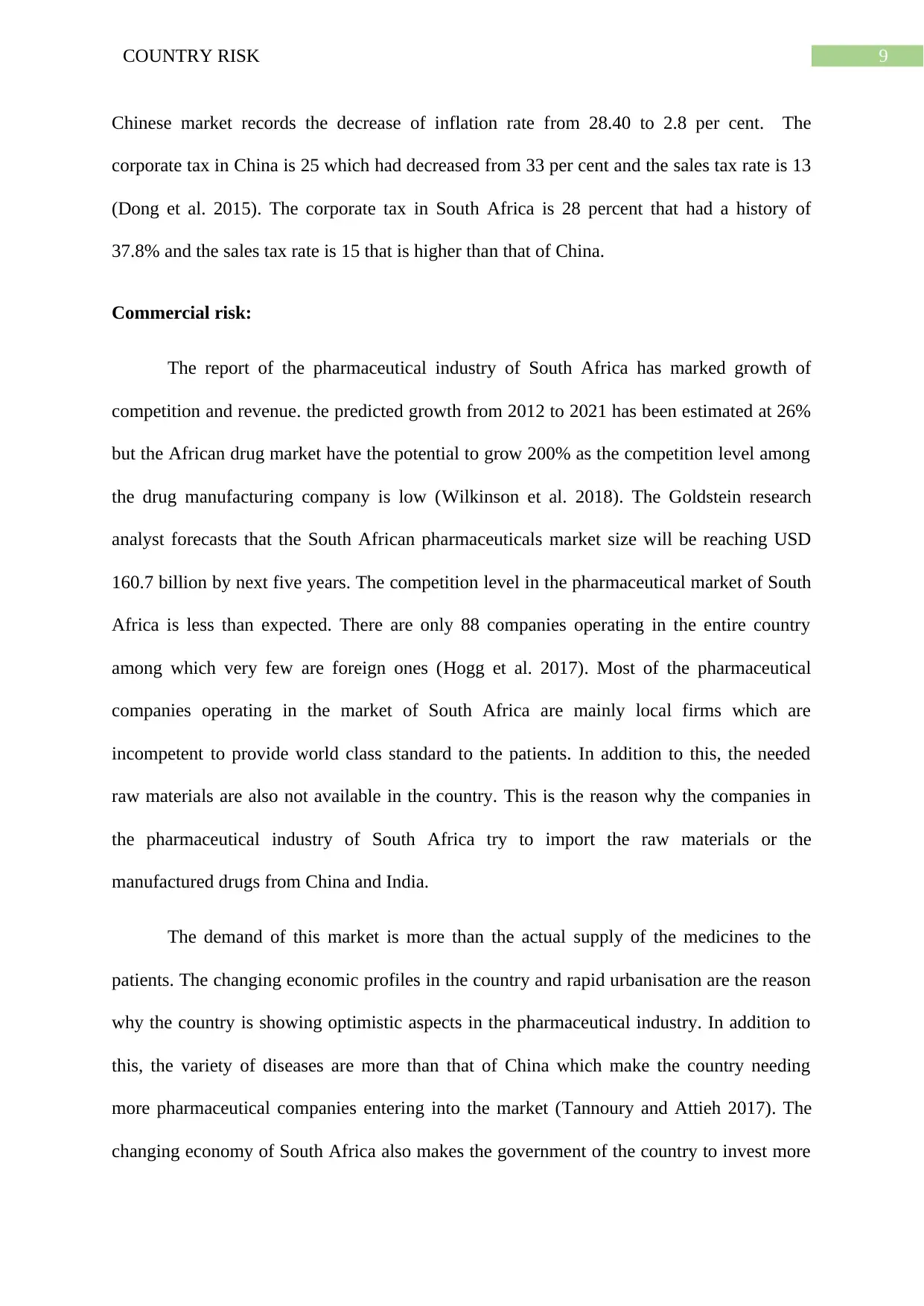
9COUNTRY RISK
Chinese market records the decrease of inflation rate from 28.40 to 2.8 per cent. The
corporate tax in China is 25 which had decreased from 33 per cent and the sales tax rate is 13
(Dong et al. 2015). The corporate tax in South Africa is 28 percent that had a history of
37.8% and the sales tax rate is 15 that is higher than that of China.
Commercial risk:
The report of the pharmaceutical industry of South Africa has marked growth of
competition and revenue. the predicted growth from 2012 to 2021 has been estimated at 26%
but the African drug market have the potential to grow 200% as the competition level among
the drug manufacturing company is low (Wilkinson et al. 2018). The Goldstein research
analyst forecasts that the South African pharmaceuticals market size will be reaching USD
160.7 billion by next five years. The competition level in the pharmaceutical market of South
Africa is less than expected. There are only 88 companies operating in the entire country
among which very few are foreign ones (Hogg et al. 2017). Most of the pharmaceutical
companies operating in the market of South Africa are mainly local firms which are
incompetent to provide world class standard to the patients. In addition to this, the needed
raw materials are also not available in the country. This is the reason why the companies in
the pharmaceutical industry of South Africa try to import the raw materials or the
manufactured drugs from China and India.
The demand of this market is more than the actual supply of the medicines to the
patients. The changing economic profiles in the country and rapid urbanisation are the reason
why the country is showing optimistic aspects in the pharmaceutical industry. In addition to
this, the variety of diseases are more than that of China which make the country needing
more pharmaceutical companies entering into the market (Tannoury and Attieh 2017). The
changing economy of South Africa also makes the government of the country to invest more
Chinese market records the decrease of inflation rate from 28.40 to 2.8 per cent. The
corporate tax in China is 25 which had decreased from 33 per cent and the sales tax rate is 13
(Dong et al. 2015). The corporate tax in South Africa is 28 percent that had a history of
37.8% and the sales tax rate is 15 that is higher than that of China.
Commercial risk:
The report of the pharmaceutical industry of South Africa has marked growth of
competition and revenue. the predicted growth from 2012 to 2021 has been estimated at 26%
but the African drug market have the potential to grow 200% as the competition level among
the drug manufacturing company is low (Wilkinson et al. 2018). The Goldstein research
analyst forecasts that the South African pharmaceuticals market size will be reaching USD
160.7 billion by next five years. The competition level in the pharmaceutical market of South
Africa is less than expected. There are only 88 companies operating in the entire country
among which very few are foreign ones (Hogg et al. 2017). Most of the pharmaceutical
companies operating in the market of South Africa are mainly local firms which are
incompetent to provide world class standard to the patients. In addition to this, the needed
raw materials are also not available in the country. This is the reason why the companies in
the pharmaceutical industry of South Africa try to import the raw materials or the
manufactured drugs from China and India.
The demand of this market is more than the actual supply of the medicines to the
patients. The changing economic profiles in the country and rapid urbanisation are the reason
why the country is showing optimistic aspects in the pharmaceutical industry. In addition to
this, the variety of diseases are more than that of China which make the country needing
more pharmaceutical companies entering into the market (Tannoury and Attieh 2017). The
changing economy of South Africa also makes the government of the country to invest more
Secure Best Marks with AI Grader
Need help grading? Try our AI Grader for instant feedback on your assignments.
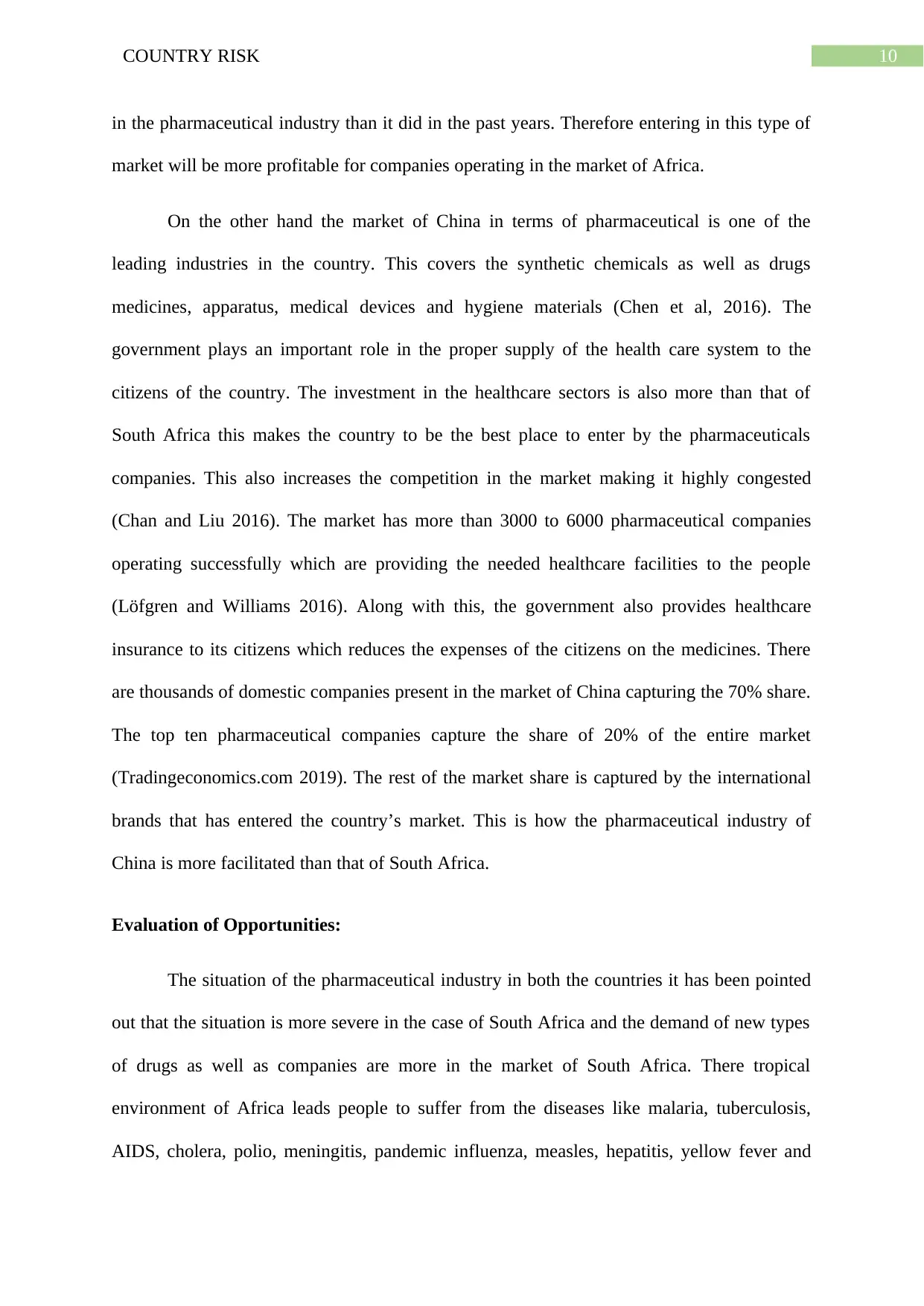
10COUNTRY RISK
in the pharmaceutical industry than it did in the past years. Therefore entering in this type of
market will be more profitable for companies operating in the market of Africa.
On the other hand the market of China in terms of pharmaceutical is one of the
leading industries in the country. This covers the synthetic chemicals as well as drugs
medicines, apparatus, medical devices and hygiene materials (Chen et al, 2016). The
government plays an important role in the proper supply of the health care system to the
citizens of the country. The investment in the healthcare sectors is also more than that of
South Africa this makes the country to be the best place to enter by the pharmaceuticals
companies. This also increases the competition in the market making it highly congested
(Chan and Liu 2016). The market has more than 3000 to 6000 pharmaceutical companies
operating successfully which are providing the needed healthcare facilities to the people
(Löfgren and Williams 2016). Along with this, the government also provides healthcare
insurance to its citizens which reduces the expenses of the citizens on the medicines. There
are thousands of domestic companies present in the market of China capturing the 70% share.
The top ten pharmaceutical companies capture the share of 20% of the entire market
(Tradingeconomics.com 2019). The rest of the market share is captured by the international
brands that has entered the country’s market. This is how the pharmaceutical industry of
China is more facilitated than that of South Africa.
Evaluation of Opportunities:
The situation of the pharmaceutical industry in both the countries it has been pointed
out that the situation is more severe in the case of South Africa and the demand of new types
of drugs as well as companies are more in the market of South Africa. There tropical
environment of Africa leads people to suffer from the diseases like malaria, tuberculosis,
AIDS, cholera, polio, meningitis, pandemic influenza, measles, hepatitis, yellow fever and
in the pharmaceutical industry than it did in the past years. Therefore entering in this type of
market will be more profitable for companies operating in the market of Africa.
On the other hand the market of China in terms of pharmaceutical is one of the
leading industries in the country. This covers the synthetic chemicals as well as drugs
medicines, apparatus, medical devices and hygiene materials (Chen et al, 2016). The
government plays an important role in the proper supply of the health care system to the
citizens of the country. The investment in the healthcare sectors is also more than that of
South Africa this makes the country to be the best place to enter by the pharmaceuticals
companies. This also increases the competition in the market making it highly congested
(Chan and Liu 2016). The market has more than 3000 to 6000 pharmaceutical companies
operating successfully which are providing the needed healthcare facilities to the people
(Löfgren and Williams 2016). Along with this, the government also provides healthcare
insurance to its citizens which reduces the expenses of the citizens on the medicines. There
are thousands of domestic companies present in the market of China capturing the 70% share.
The top ten pharmaceutical companies capture the share of 20% of the entire market
(Tradingeconomics.com 2019). The rest of the market share is captured by the international
brands that has entered the country’s market. This is how the pharmaceutical industry of
China is more facilitated than that of South Africa.
Evaluation of Opportunities:
The situation of the pharmaceutical industry in both the countries it has been pointed
out that the situation is more severe in the case of South Africa and the demand of new types
of drugs as well as companies are more in the market of South Africa. There tropical
environment of Africa leads people to suffer from the diseases like malaria, tuberculosis,
AIDS, cholera, polio, meningitis, pandemic influenza, measles, hepatitis, yellow fever and
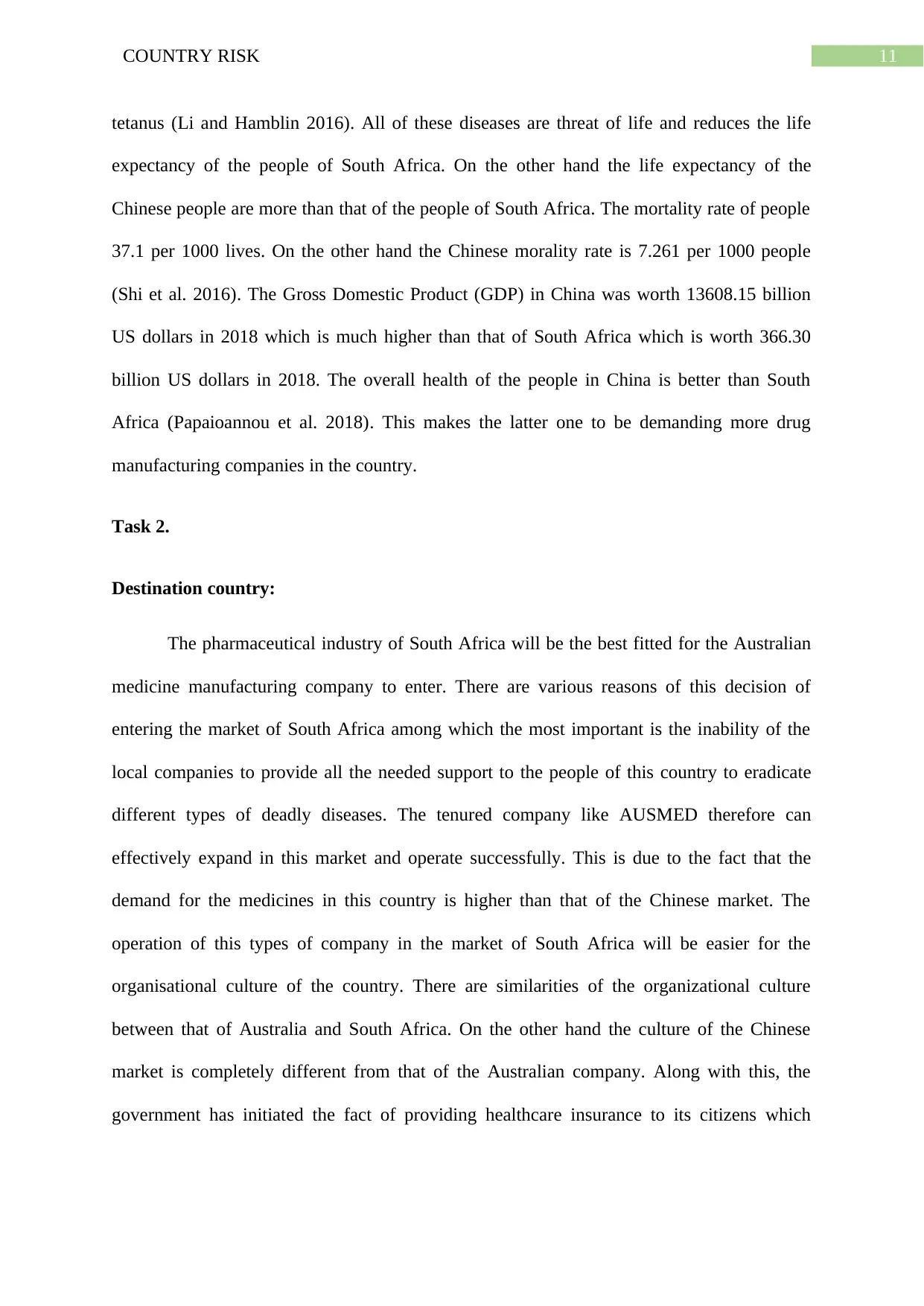
11COUNTRY RISK
tetanus (Li and Hamblin 2016). All of these diseases are threat of life and reduces the life
expectancy of the people of South Africa. On the other hand the life expectancy of the
Chinese people are more than that of the people of South Africa. The mortality rate of people
37.1 per 1000 lives. On the other hand the Chinese morality rate is 7.261 per 1000 people
(Shi et al. 2016). The Gross Domestic Product (GDP) in China was worth 13608.15 billion
US dollars in 2018 which is much higher than that of South Africa which is worth 366.30
billion US dollars in 2018. The overall health of the people in China is better than South
Africa (Papaioannou et al. 2018). This makes the latter one to be demanding more drug
manufacturing companies in the country.
Task 2.
Destination country:
The pharmaceutical industry of South Africa will be the best fitted for the Australian
medicine manufacturing company to enter. There are various reasons of this decision of
entering the market of South Africa among which the most important is the inability of the
local companies to provide all the needed support to the people of this country to eradicate
different types of deadly diseases. The tenured company like AUSMED therefore can
effectively expand in this market and operate successfully. This is due to the fact that the
demand for the medicines in this country is higher than that of the Chinese market. The
operation of this types of company in the market of South Africa will be easier for the
organisational culture of the country. There are similarities of the organizational culture
between that of Australia and South Africa. On the other hand the culture of the Chinese
market is completely different from that of the Australian company. Along with this, the
government has initiated the fact of providing healthcare insurance to its citizens which
tetanus (Li and Hamblin 2016). All of these diseases are threat of life and reduces the life
expectancy of the people of South Africa. On the other hand the life expectancy of the
Chinese people are more than that of the people of South Africa. The mortality rate of people
37.1 per 1000 lives. On the other hand the Chinese morality rate is 7.261 per 1000 people
(Shi et al. 2016). The Gross Domestic Product (GDP) in China was worth 13608.15 billion
US dollars in 2018 which is much higher than that of South Africa which is worth 366.30
billion US dollars in 2018. The overall health of the people in China is better than South
Africa (Papaioannou et al. 2018). This makes the latter one to be demanding more drug
manufacturing companies in the country.
Task 2.
Destination country:
The pharmaceutical industry of South Africa will be the best fitted for the Australian
medicine manufacturing company to enter. There are various reasons of this decision of
entering the market of South Africa among which the most important is the inability of the
local companies to provide all the needed support to the people of this country to eradicate
different types of deadly diseases. The tenured company like AUSMED therefore can
effectively expand in this market and operate successfully. This is due to the fact that the
demand for the medicines in this country is higher than that of the Chinese market. The
operation of this types of company in the market of South Africa will be easier for the
organisational culture of the country. There are similarities of the organizational culture
between that of Australia and South Africa. On the other hand the culture of the Chinese
market is completely different from that of the Australian company. Along with this, the
government has initiated the fact of providing healthcare insurance to its citizens which
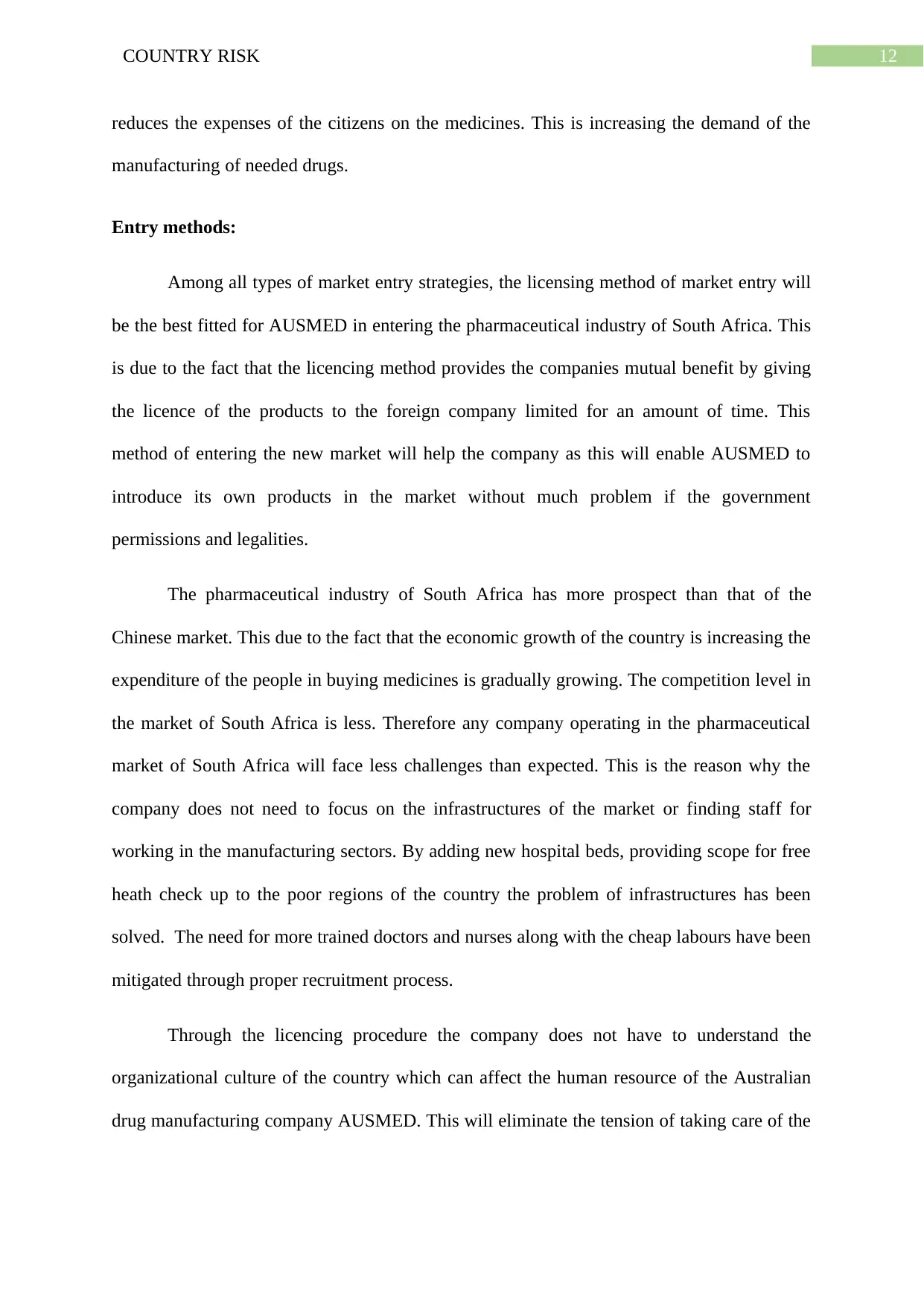
12COUNTRY RISK
reduces the expenses of the citizens on the medicines. This is increasing the demand of the
manufacturing of needed drugs.
Entry methods:
Among all types of market entry strategies, the licensing method of market entry will
be the best fitted for AUSMED in entering the pharmaceutical industry of South Africa. This
is due to the fact that the licencing method provides the companies mutual benefit by giving
the licence of the products to the foreign company limited for an amount of time. This
method of entering the new market will help the company as this will enable AUSMED to
introduce its own products in the market without much problem if the government
permissions and legalities.
The pharmaceutical industry of South Africa has more prospect than that of the
Chinese market. This due to the fact that the economic growth of the country is increasing the
expenditure of the people in buying medicines is gradually growing. The competition level in
the market of South Africa is less. Therefore any company operating in the pharmaceutical
market of South Africa will face less challenges than expected. This is the reason why the
company does not need to focus on the infrastructures of the market or finding staff for
working in the manufacturing sectors. By adding new hospital beds, providing scope for free
heath check up to the poor regions of the country the problem of infrastructures has been
solved. The need for more trained doctors and nurses along with the cheap labours have been
mitigated through proper recruitment process.
Through the licencing procedure the company does not have to understand the
organizational culture of the country which can affect the human resource of the Australian
drug manufacturing company AUSMED. This will eliminate the tension of taking care of the
reduces the expenses of the citizens on the medicines. This is increasing the demand of the
manufacturing of needed drugs.
Entry methods:
Among all types of market entry strategies, the licensing method of market entry will
be the best fitted for AUSMED in entering the pharmaceutical industry of South Africa. This
is due to the fact that the licencing method provides the companies mutual benefit by giving
the licence of the products to the foreign company limited for an amount of time. This
method of entering the new market will help the company as this will enable AUSMED to
introduce its own products in the market without much problem if the government
permissions and legalities.
The pharmaceutical industry of South Africa has more prospect than that of the
Chinese market. This due to the fact that the economic growth of the country is increasing the
expenditure of the people in buying medicines is gradually growing. The competition level in
the market of South Africa is less. Therefore any company operating in the pharmaceutical
market of South Africa will face less challenges than expected. This is the reason why the
company does not need to focus on the infrastructures of the market or finding staff for
working in the manufacturing sectors. By adding new hospital beds, providing scope for free
heath check up to the poor regions of the country the problem of infrastructures has been
solved. The need for more trained doctors and nurses along with the cheap labours have been
mitigated through proper recruitment process.
Through the licencing procedure the company does not have to understand the
organizational culture of the country which can affect the human resource of the Australian
drug manufacturing company AUSMED. This will eliminate the tension of taking care of the
Paraphrase This Document
Need a fresh take? Get an instant paraphrase of this document with our AI Paraphraser
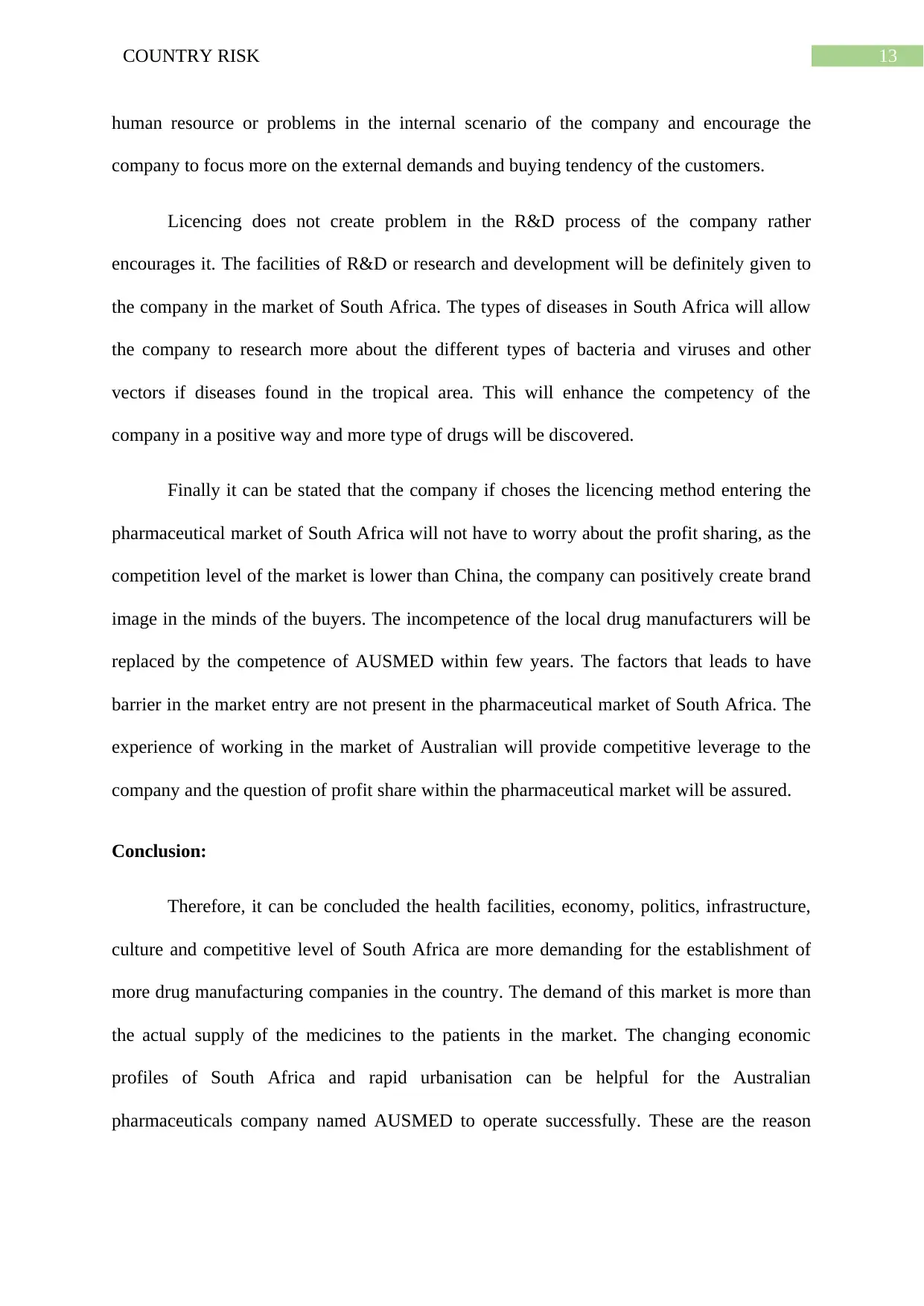
13COUNTRY RISK
human resource or problems in the internal scenario of the company and encourage the
company to focus more on the external demands and buying tendency of the customers.
Licencing does not create problem in the R&D process of the company rather
encourages it. The facilities of R&D or research and development will be definitely given to
the company in the market of South Africa. The types of diseases in South Africa will allow
the company to research more about the different types of bacteria and viruses and other
vectors if diseases found in the tropical area. This will enhance the competency of the
company in a positive way and more type of drugs will be discovered.
Finally it can be stated that the company if choses the licencing method entering the
pharmaceutical market of South Africa will not have to worry about the profit sharing, as the
competition level of the market is lower than China, the company can positively create brand
image in the minds of the buyers. The incompetence of the local drug manufacturers will be
replaced by the competence of AUSMED within few years. The factors that leads to have
barrier in the market entry are not present in the pharmaceutical market of South Africa. The
experience of working in the market of Australian will provide competitive leverage to the
company and the question of profit share within the pharmaceutical market will be assured.
Conclusion:
Therefore, it can be concluded the health facilities, economy, politics, infrastructure,
culture and competitive level of South Africa are more demanding for the establishment of
more drug manufacturing companies in the country. The demand of this market is more than
the actual supply of the medicines to the patients in the market. The changing economic
profiles of South Africa and rapid urbanisation can be helpful for the Australian
pharmaceuticals company named AUSMED to operate successfully. These are the reason
human resource or problems in the internal scenario of the company and encourage the
company to focus more on the external demands and buying tendency of the customers.
Licencing does not create problem in the R&D process of the company rather
encourages it. The facilities of R&D or research and development will be definitely given to
the company in the market of South Africa. The types of diseases in South Africa will allow
the company to research more about the different types of bacteria and viruses and other
vectors if diseases found in the tropical area. This will enhance the competency of the
company in a positive way and more type of drugs will be discovered.
Finally it can be stated that the company if choses the licencing method entering the
pharmaceutical market of South Africa will not have to worry about the profit sharing, as the
competition level of the market is lower than China, the company can positively create brand
image in the minds of the buyers. The incompetence of the local drug manufacturers will be
replaced by the competence of AUSMED within few years. The factors that leads to have
barrier in the market entry are not present in the pharmaceutical market of South Africa. The
experience of working in the market of Australian will provide competitive leverage to the
company and the question of profit share within the pharmaceutical market will be assured.
Conclusion:
Therefore, it can be concluded the health facilities, economy, politics, infrastructure,
culture and competitive level of South Africa are more demanding for the establishment of
more drug manufacturing companies in the country. The demand of this market is more than
the actual supply of the medicines to the patients in the market. The changing economic
profiles of South Africa and rapid urbanisation can be helpful for the Australian
pharmaceuticals company named AUSMED to operate successfully. These are the reason
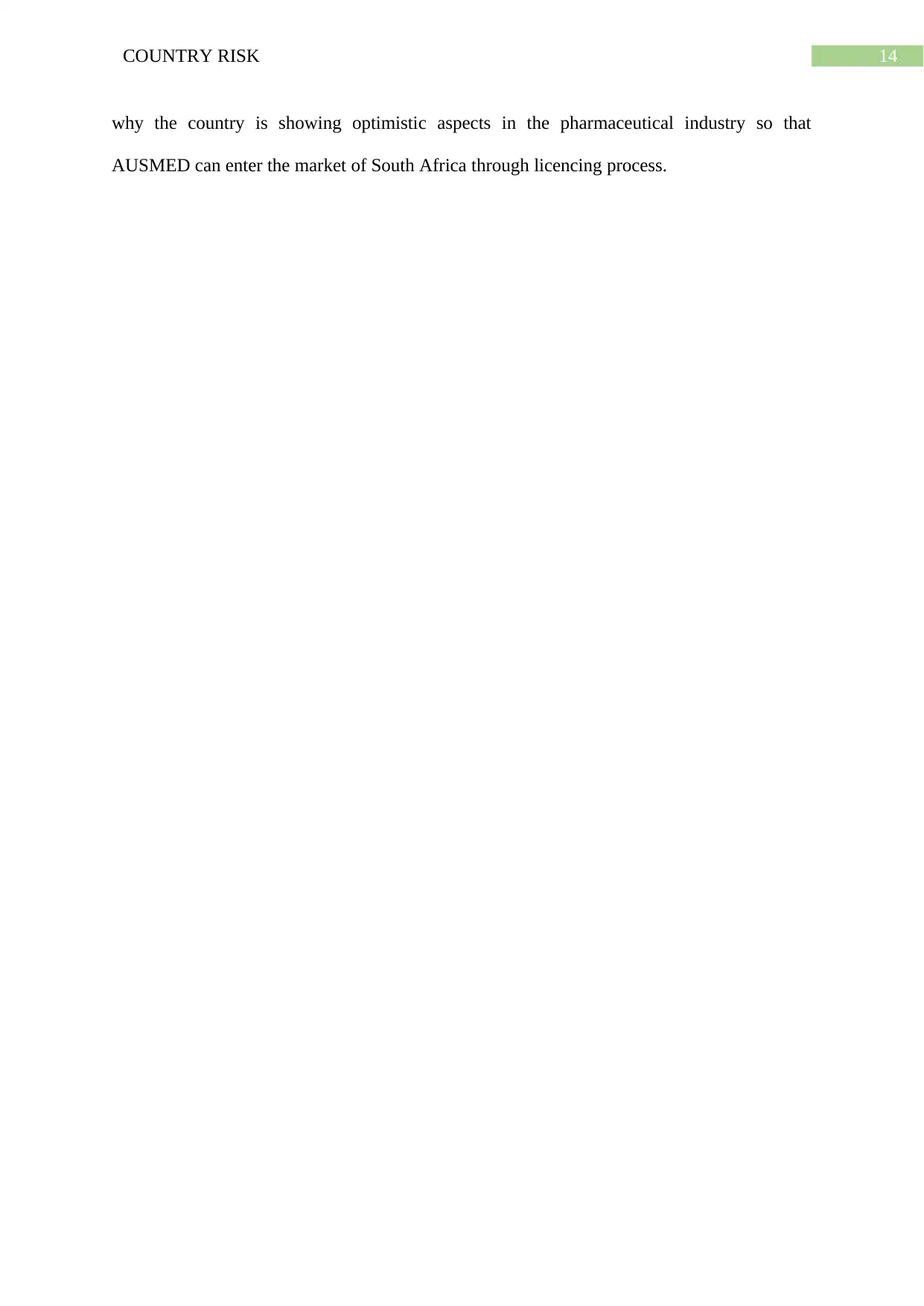
14COUNTRY RISK
why the country is showing optimistic aspects in the pharmaceutical industry so that
AUSMED can enter the market of South Africa through licencing process.
why the country is showing optimistic aspects in the pharmaceutical industry so that
AUSMED can enter the market of South Africa through licencing process.
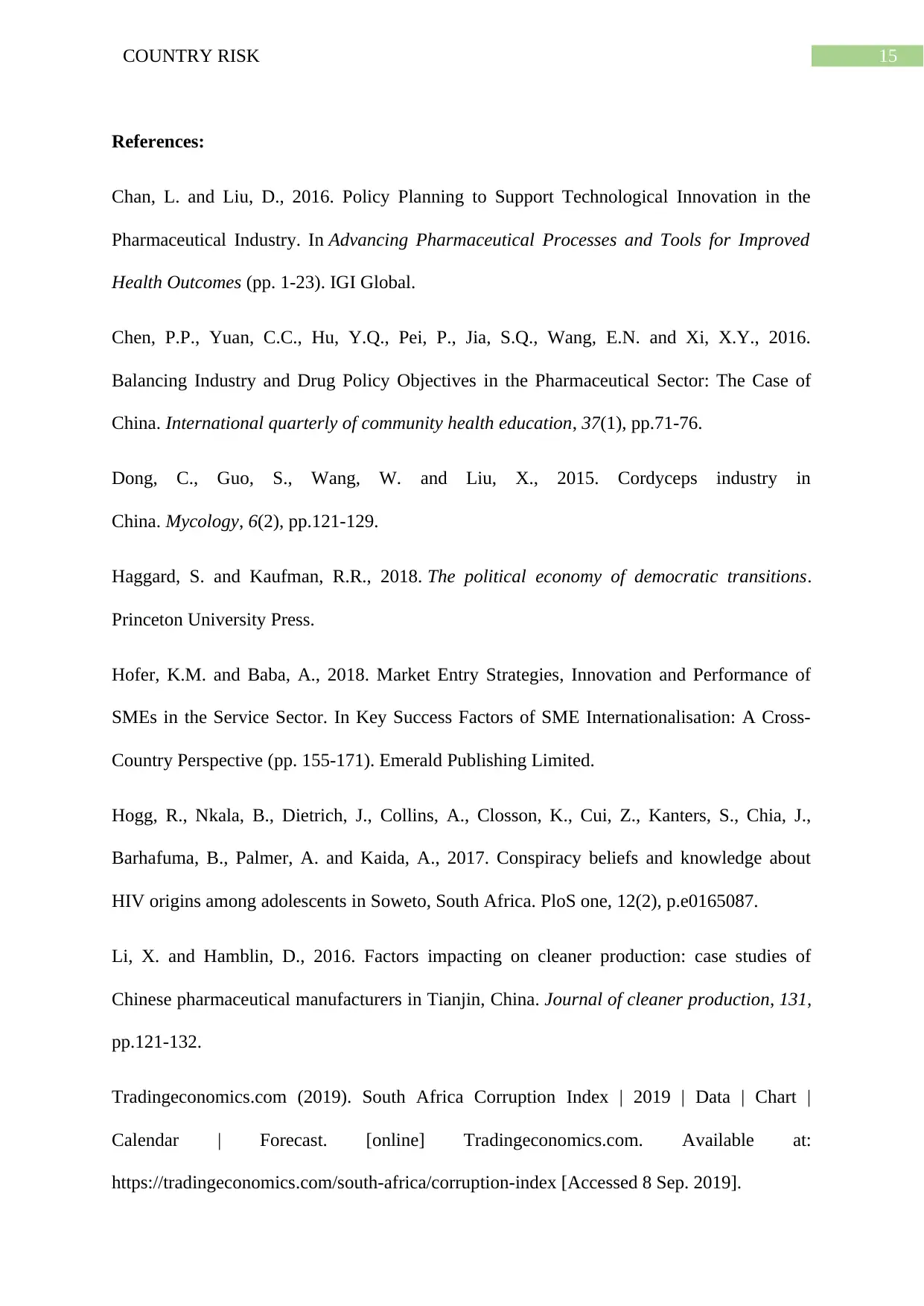
15COUNTRY RISK
References:
Chan, L. and Liu, D., 2016. Policy Planning to Support Technological Innovation in the
Pharmaceutical Industry. In Advancing Pharmaceutical Processes and Tools for Improved
Health Outcomes (pp. 1-23). IGI Global.
Chen, P.P., Yuan, C.C., Hu, Y.Q., Pei, P., Jia, S.Q., Wang, E.N. and Xi, X.Y., 2016.
Balancing Industry and Drug Policy Objectives in the Pharmaceutical Sector: The Case of
China. International quarterly of community health education, 37(1), pp.71-76.
Dong, C., Guo, S., Wang, W. and Liu, X., 2015. Cordyceps industry in
China. Mycology, 6(2), pp.121-129.
Haggard, S. and Kaufman, R.R., 2018. The political economy of democratic transitions.
Princeton University Press.
Hofer, K.M. and Baba, A., 2018. Market Entry Strategies, Innovation and Performance of
SMEs in the Service Sector. In Key Success Factors of SME Internationalisation: A Cross-
Country Perspective (pp. 155-171). Emerald Publishing Limited.
Hogg, R., Nkala, B., Dietrich, J., Collins, A., Closson, K., Cui, Z., Kanters, S., Chia, J.,
Barhafuma, B., Palmer, A. and Kaida, A., 2017. Conspiracy beliefs and knowledge about
HIV origins among adolescents in Soweto, South Africa. PloS one, 12(2), p.e0165087.
Li, X. and Hamblin, D., 2016. Factors impacting on cleaner production: case studies of
Chinese pharmaceutical manufacturers in Tianjin, China. Journal of cleaner production, 131,
pp.121-132.
Tradingeconomics.com (2019). South Africa Corruption Index | 2019 | Data | Chart |
Calendar | Forecast. [online] Tradingeconomics.com. Available at:
https://tradingeconomics.com/south-africa/corruption-index [Accessed 8 Sep. 2019].
References:
Chan, L. and Liu, D., 2016. Policy Planning to Support Technological Innovation in the
Pharmaceutical Industry. In Advancing Pharmaceutical Processes and Tools for Improved
Health Outcomes (pp. 1-23). IGI Global.
Chen, P.P., Yuan, C.C., Hu, Y.Q., Pei, P., Jia, S.Q., Wang, E.N. and Xi, X.Y., 2016.
Balancing Industry and Drug Policy Objectives in the Pharmaceutical Sector: The Case of
China. International quarterly of community health education, 37(1), pp.71-76.
Dong, C., Guo, S., Wang, W. and Liu, X., 2015. Cordyceps industry in
China. Mycology, 6(2), pp.121-129.
Haggard, S. and Kaufman, R.R., 2018. The political economy of democratic transitions.
Princeton University Press.
Hofer, K.M. and Baba, A., 2018. Market Entry Strategies, Innovation and Performance of
SMEs in the Service Sector. In Key Success Factors of SME Internationalisation: A Cross-
Country Perspective (pp. 155-171). Emerald Publishing Limited.
Hogg, R., Nkala, B., Dietrich, J., Collins, A., Closson, K., Cui, Z., Kanters, S., Chia, J.,
Barhafuma, B., Palmer, A. and Kaida, A., 2017. Conspiracy beliefs and knowledge about
HIV origins among adolescents in Soweto, South Africa. PloS one, 12(2), p.e0165087.
Li, X. and Hamblin, D., 2016. Factors impacting on cleaner production: case studies of
Chinese pharmaceutical manufacturers in Tianjin, China. Journal of cleaner production, 131,
pp.121-132.
Tradingeconomics.com (2019). South Africa Corruption Index | 2019 | Data | Chart |
Calendar | Forecast. [online] Tradingeconomics.com. Available at:
https://tradingeconomics.com/south-africa/corruption-index [Accessed 8 Sep. 2019].
Secure Best Marks with AI Grader
Need help grading? Try our AI Grader for instant feedback on your assignments.
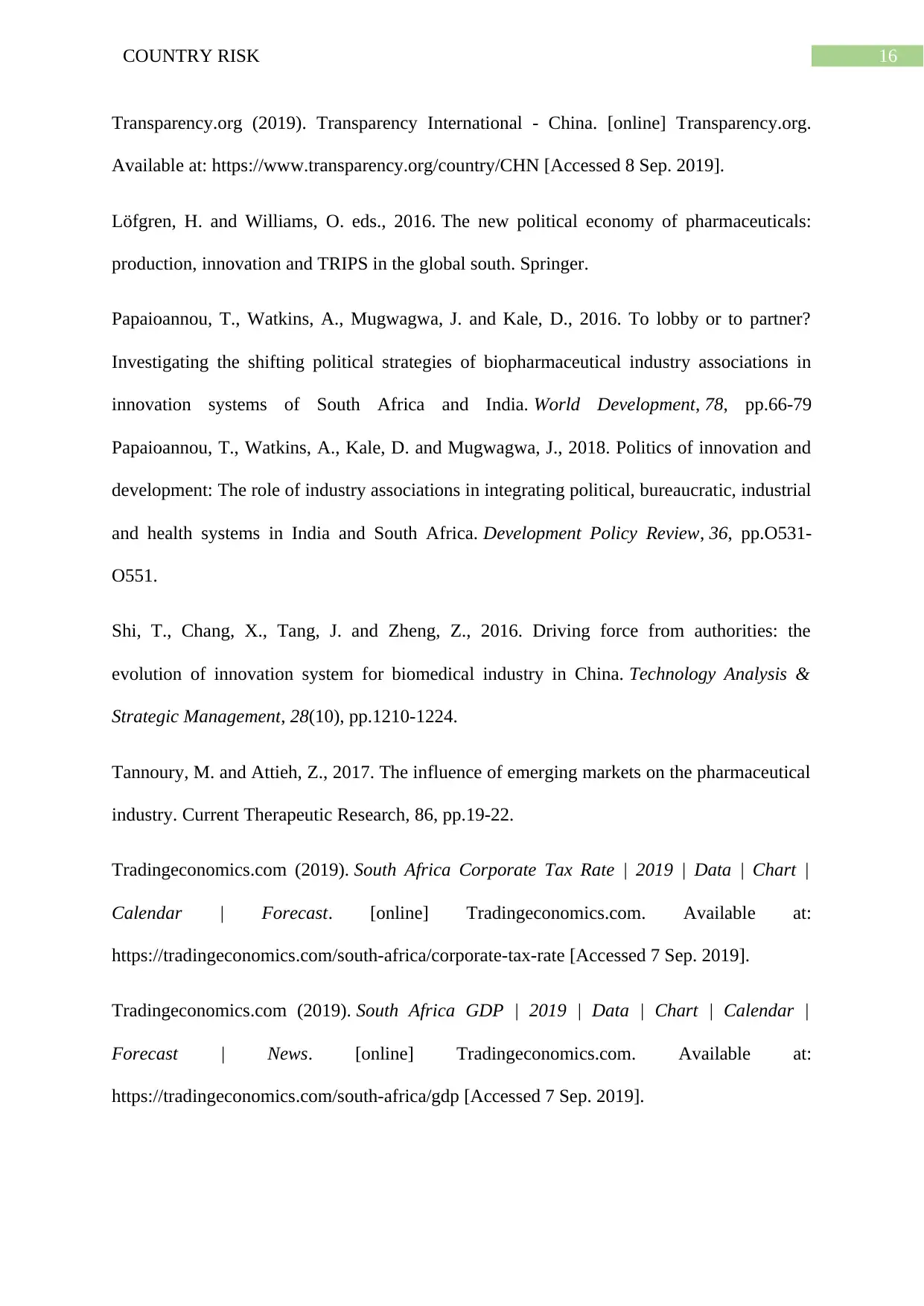
16COUNTRY RISK
Transparency.org (2019). Transparency International - China. [online] Transparency.org.
Available at: https://www.transparency.org/country/CHN [Accessed 8 Sep. 2019].
Löfgren, H. and Williams, O. eds., 2016. The new political economy of pharmaceuticals:
production, innovation and TRIPS in the global south. Springer.
Papaioannou, T., Watkins, A., Mugwagwa, J. and Kale, D., 2016. To lobby or to partner?
Investigating the shifting political strategies of biopharmaceutical industry associations in
innovation systems of South Africa and India. World Development, 78, pp.66-79
Papaioannou, T., Watkins, A., Kale, D. and Mugwagwa, J., 2018. Politics of innovation and
development: The role of industry associations in integrating political, bureaucratic, industrial
and health systems in India and South Africa. Development Policy Review, 36, pp.O531-
O551.
Shi, T., Chang, X., Tang, J. and Zheng, Z., 2016. Driving force from authorities: the
evolution of innovation system for biomedical industry in China. Technology Analysis &
Strategic Management, 28(10), pp.1210-1224.
Tannoury, M. and Attieh, Z., 2017. The influence of emerging markets on the pharmaceutical
industry. Current Therapeutic Research, 86, pp.19-22.
Tradingeconomics.com (2019). South Africa Corporate Tax Rate | 2019 | Data | Chart |
Calendar | Forecast. [online] Tradingeconomics.com. Available at:
https://tradingeconomics.com/south-africa/corporate-tax-rate [Accessed 7 Sep. 2019].
Tradingeconomics.com (2019). South Africa GDP | 2019 | Data | Chart | Calendar |
Forecast | News. [online] Tradingeconomics.com. Available at:
https://tradingeconomics.com/south-africa/gdp [Accessed 7 Sep. 2019].
Transparency.org (2019). Transparency International - China. [online] Transparency.org.
Available at: https://www.transparency.org/country/CHN [Accessed 8 Sep. 2019].
Löfgren, H. and Williams, O. eds., 2016. The new political economy of pharmaceuticals:
production, innovation and TRIPS in the global south. Springer.
Papaioannou, T., Watkins, A., Mugwagwa, J. and Kale, D., 2016. To lobby or to partner?
Investigating the shifting political strategies of biopharmaceutical industry associations in
innovation systems of South Africa and India. World Development, 78, pp.66-79
Papaioannou, T., Watkins, A., Kale, D. and Mugwagwa, J., 2018. Politics of innovation and
development: The role of industry associations in integrating political, bureaucratic, industrial
and health systems in India and South Africa. Development Policy Review, 36, pp.O531-
O551.
Shi, T., Chang, X., Tang, J. and Zheng, Z., 2016. Driving force from authorities: the
evolution of innovation system for biomedical industry in China. Technology Analysis &
Strategic Management, 28(10), pp.1210-1224.
Tannoury, M. and Attieh, Z., 2017. The influence of emerging markets on the pharmaceutical
industry. Current Therapeutic Research, 86, pp.19-22.
Tradingeconomics.com (2019). South Africa Corporate Tax Rate | 2019 | Data | Chart |
Calendar | Forecast. [online] Tradingeconomics.com. Available at:
https://tradingeconomics.com/south-africa/corporate-tax-rate [Accessed 7 Sep. 2019].
Tradingeconomics.com (2019). South Africa GDP | 2019 | Data | Chart | Calendar |
Forecast | News. [online] Tradingeconomics.com. Available at:
https://tradingeconomics.com/south-africa/gdp [Accessed 7 Sep. 2019].
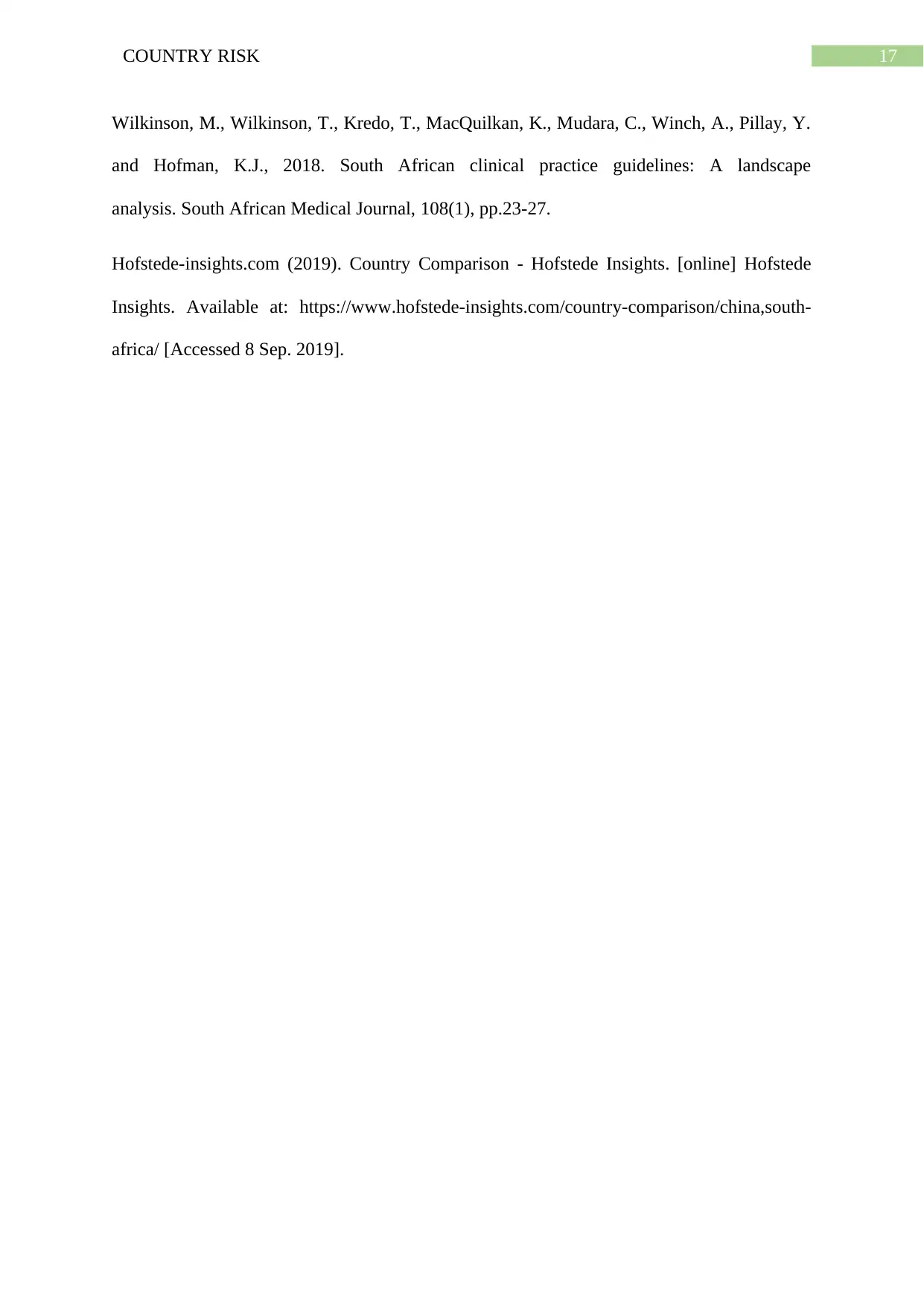
17COUNTRY RISK
Wilkinson, M., Wilkinson, T., Kredo, T., MacQuilkan, K., Mudara, C., Winch, A., Pillay, Y.
and Hofman, K.J., 2018. South African clinical practice guidelines: A landscape
analysis. South African Medical Journal, 108(1), pp.23-27.
Hofstede-insights.com (2019). Country Comparison - Hofstede Insights. [online] Hofstede
Insights. Available at: https://www.hofstede-insights.com/country-comparison/china,south-
africa/ [Accessed 8 Sep. 2019].
Wilkinson, M., Wilkinson, T., Kredo, T., MacQuilkan, K., Mudara, C., Winch, A., Pillay, Y.
and Hofman, K.J., 2018. South African clinical practice guidelines: A landscape
analysis. South African Medical Journal, 108(1), pp.23-27.
Hofstede-insights.com (2019). Country Comparison - Hofstede Insights. [online] Hofstede
Insights. Available at: https://www.hofstede-insights.com/country-comparison/china,south-
africa/ [Accessed 8 Sep. 2019].
1 out of 18
Related Documents
Your All-in-One AI-Powered Toolkit for Academic Success.
+13062052269
info@desklib.com
Available 24*7 on WhatsApp / Email
![[object Object]](/_next/static/media/star-bottom.7253800d.svg)
Unlock your academic potential
© 2024 | Zucol Services PVT LTD | All rights reserved.



